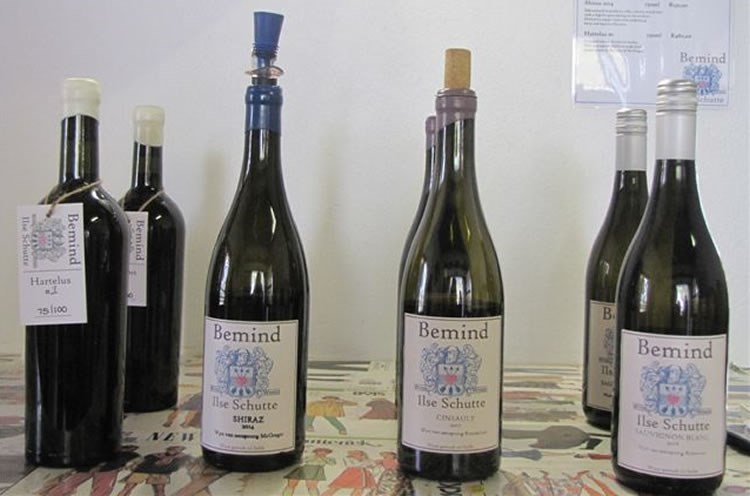Afrikaans, the everyday language of the winelands for many farmers, winemakers and workers is inspiring some of the most evocative wine labels coming out of the Cape today - names that communicate an authentic sense of provenance, pride and place.
If wine brands like Hermanuspietersfontein Wynkelder - surely one of the longest winery names in the vernacular in the world - can thrive, there’s no limit to proudly Afrikaans wine labels. When former winemaker Bartho Eksteen created best-selling wines like Swartskaap, Kleinboet and Kat met die Houtbeen, there was no compromise on labels that told a story with authenticity. What’s in a name? Heritage Cape wineries with tongue-twister old Cape Dutch names like Allesverloren (1704), Buitenverwachting (1796), Rust en Vrede (1694), Twee Jonge Gezellen (1710) and Vergelegen (1700) have thrived over the centuries on domestic and export markets.
I started thinking about the linguistics of labels after attending an open day at Hout Bay Vineyards, a boutique wine cellar pioneering new viticultural terroir high on the mountain slopes of the Cape Peninsula. Over a tasting led by owner Peter Roeloffze I wondered if he’d had any trademark disputes over his flagship Rhône blend boldly labelled Petrus. Petrus is a name associated for centuries with one of the finest first growths of Bordeaux and Merlot in the Pomerol appellation. “I’ll export it anywhere I want to” retorted the winemaker, “Petrus is my birthright, it’s my own name in Afrikaans!” (The back labels are also in Afrikaans - good on Peter, I mean Petrus.)
On a recent tour of boutique wineries in the Robertson Wine Valley including Kleinhoekkloof, Jan Harmsgat, Lord’s, Tanagra and Kranskop, I was again reminded of proudly Afrikaans wine labels when I met winemaker Ilse Schutte who opened Bemind (Beloved) Wyne in McGregor in 2015. Her motto, “Wyne gemaak uit liefde” is on every Afrikaans label, along with a charming poem, “Verewig omsingel in die druppels van my wyn. Ek gee, Ek ontvang. Mense, my mense, kom binne, my Beminde”. We enjoyed her fabulous Sauvignon and Shiraz. Her Hartelus Merlot #1, a limited release of 100 bottles (R480 each) made using her basket press from grapes grown in a small vineyard in McGregor - but understandably, not opened for visitors.

I also tasted a delightful single vineyard wine from Mont Blois (founded 1884) in the Robertson Wine Valley - a flagship barrel-fermented wine labelled Groot Steen 2016 (R295). Winemaker Ernst Bruwer, “sesde generasie” of this family of grape growers, stands proudly behind a “wyn van oorsprong, gekweek en gemaak op the Mont Blois wynlandgoed” (I’m quoting directly from the wording of the Afrikaans wine label). And I enjoyed catching up with Newald Marais, one of South Africa’s most experienced winemakers at Kranskop in Klaasvoogds Valley, who has forty vintages under his belt. After a barrel tasting of his wonderful Chardonnay, Sauvignon Blanc, Viognier, Tannat, Cabernet and Merlot, we shared lunch of hearty plaas roosterkoeke.
Chenin Blanc, more than any other wine, celebrates the Afrikaans heritage of South Africa’s most widely planted variety on wine labels. The heritage of old bush vines, the most traditional way of cultivating vines, is a key aspect of the wine brand story on labels - take Rheboksloof Bosstok Chenin and Alheit’s Makstok (ungrafted Chenin). I’ve also come across Beaumont’s “Moerse Moer” Chenin Blanc and Neil Ellis’ “Op sy Moer” Chenin blend - a double entendre, meaning “on the lees”. We could do with more light-hearted humour and less pretension on wine labels.
You don’t get more Capie than that saying. Or Daniël de Waal’s Pella Kanniedood Chenin Blanc - a tribute to the staying power of old bush vines. His Super Single Vineyards in the Stellenboschkloof have come up with some marvellous wine labels - Oukliprant Malbec and Granietbult Cabernet Sauvignon to name a few. The evocative place names of single vineyards express the provenance of these wines - from David & Nadia Sadie’s (Shale) Skaliekop to Kaapzicht’s The 1947 and Kliprug Chenin. You can’t make up place names like Piekenierskloof and Mount Abora Koggelbos.
And Steen, the defiant old moniker of Chenin Blanc, is creeping back into fashion. Spearheaded by Mulderbosch’s pioneering Steen op Hout, Steen is back on labels from AA Badenhorst’s Dassiekop Steen and Ronnie B’s Patatsfontein Steen to David & Nadia Sadie’s Hoë-Steen, Jean-Engelbrecht’s Donkiesbaai Steen - Hoeksteen and Klipspringer Swartland Steen (both from Fledge & Co). And let me not forget Longridge’s “Ou Steen Enkel Wingerd” Chenin Blanc, a mouthful of pure Chenin from a 36-year-old Stellenbosch vineyard which says it all in the vernacular.
Every wine tells a story - so I’ll end with Joostenberg Die Agteros Chenin Blanc - one of my favourite new discoveries. This organic wine, based on an old saying “die agteros kom ook in die kraal” tells a tale of patience and persistence, of waiting decades for vineyards to reach their full potential. It’s a parable of Chenin in many ways. You can’t keep a good steen down. It’s proud of its roots - I mean bosstok.
A new generation of Cape wines made by black owner winemakers with vernacular brands is already making its mark - led by pioneers such as M’hudi, ReMogo (Stand together in Setswana), Bayede! (the royal Zulu greeting), Springfontein/Ulumbaza (under renowned cellar master Tariro Masayati and viticulturist Hildegard Witbooi), Stellekaya, Thandi, Thembi and Thokozani (a wine empowerment venture between Diemersfontein, its workers, and Woolworths). Now that’s also worthy of a dedicated column on the virtues of vernacular wine labels one of these days. Local is lekker.